England's
Remote Duchy of Cornwall
Part 1 : An Ancient Land of Myth and Mystery
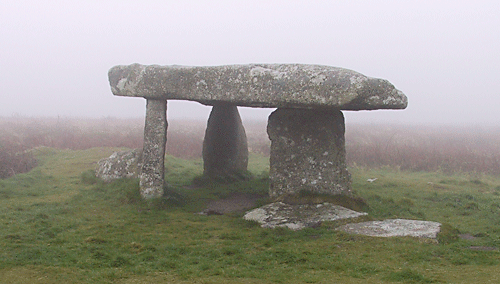
Ancient and puzzling
Lanyon Quoit on a misty moor evokes all the myth and
mystery of classic Cornwall.
|
Cornwall - A Different Heritage
to the Rest of England |
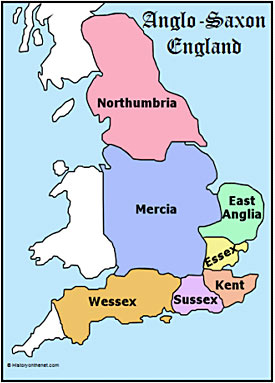
In this map of Anglo-Saxon England; Cornwall, Wales, and
Scotland are all omitted as not being part of England.
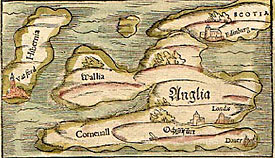
Even as 'recently' as 1550, Cornwall rated a separate
mention on maps of Britain.
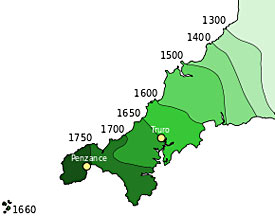
The retreating boundaries of where Cornish was
formerly spoken.
|
It is correctly
said that in Europe, the concept of countries and their borders varies
depending on when a map was drawn.
Not so appreciated is that the same is
true of Britain, which is an amalgamation of a dozen or more earlier
fiefdoms, similar to what happened hundreds of years later in the formations of
Germany and Italy in the 19th century.
Ireland, Scotland and Wales are the best known
of these formerly separate nations, and have now had various degrees of
independence restored to them. But there are many more,
and
the region with the strongest claim to becoming the
next semi-independent nation within Britain is probably Cornwall.
This is perhaps unsurprising, because Ireland, Wales and Scotland are
all at the various geographical extremities of Britain, and so too is Cornwall, at the
southwestern extremity. Its geographic remoteness is coupled with a strong sense of historic independence and even some sense
of current self-identity, being a semi-autonomous duchy with slightly different
procedures and processes to the rest of England.
Also like these other regions, it too has its own language, even more close
to moribund, called Cornish. Cornish is another Gaelic derivative, but quite
different from the Welsh or Scottish or Irish variants.
The Cornish language almost
completely died out around the early years of the 20th century, but now, 100
years later, semi-successful efforts are underway to revive it.
An indication of how much of the language has been lost
is given by there now being arguments as to which of three different revived/recreated/invented versions
of the language is the most correct. |
|
Cornwall - A Palpably Different 'Feel' |
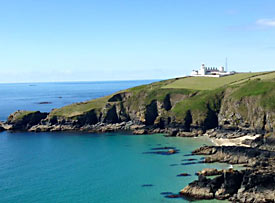
Lizard Point and its lighthouse, the southern most tip of
England.
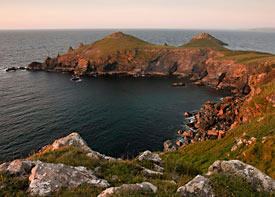
Rumps Point, just south of Port Isaac, in the setting sun
on a summer's eve.
|
There's another reason Cornwall has claim to special treatment. It
truly does 'feel different' to much of the rest of England.
The same is true
of some of Wales, and also of the highlands and islands of Scotland (less so of
the lowlands which is perhaps why the lowlands were contested territory for
hundreds of years).
It isn't always easy to
exactly explain what the difference is, but you don't have to be able to explain
something to know that it exists.
Part of the difference is perhaps recognized in the 12
different
designated
Areas of Outstanding Natural Beauty that make up 27%
of the entire region.
Why not come see for yourself and decide how best to
describe Cornwall's special character.
|
|
A Land of Myth and Legend
|
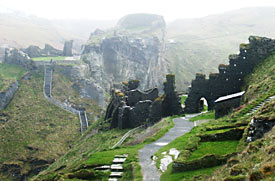
Tintagel Castle (or, at least, the sprawling ruins
thereof) looking very atmospheric in the mist, and the
reputed birthplace of King Arthur.
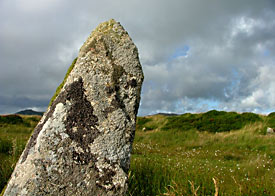
King Arthur's Hall on Bodmin Moor. The moor is home
to many mysteries and mysterious
structures, and also to the 'Beast of Bodmin' - some
type of wild cat such as a leopard, panther or puma that
is occasionally sighted on the moor.
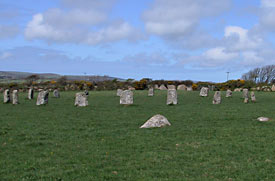
The 'Merry Maidens' Stone Circle in Cornwall, said to be
19 girls turned into stone as a punishment for dancing on
a Sunday.
|
Talking about hard to explain things, Cornwall is a land steeped in myth and legend. The stories of King Arthur are
based in Cornwall - he is said to have been born at Tintagel Castle.
A
society for the preservation and revival of Cornish culture - the Federation of
Old Cornwall Societies - has as its motto 'King Arthur is not Dead'.
Cornish legend maintains that Arthur did not die at Mordred's hands, but will
instead return to vanquish future enemies of his realm, hence their motto.
The King Arthur legend flows directly into the stories of the quest for the
Holy Grail and the knight Perceval (Parsifal) who first went to King Arthur's
Court before continuing on his question.
And from the Parsifal story and the opera written by Richard Wagner, it is a short step to perhaps the most moving of Wagner's operas, Tristan and Isolde, a searing love story right from the tragedy
promised in its first three bars, teased unbearably throughout the second Act, and finally
delivered in overwhelming intensity in the final six minute Liebestod.
The opera is set
in Cornwall, more or less in Arthurian times, and makes Romeo and Juliet look
like a trite Mills and Boone romance complete with a (comparatively) happy ending.
No-one who visits Cornwall can fail to appreciate the appropriateness of
setting perhaps the most overwhelming of all love tragedies in such a location.
Although, yes, it is true that some parts of Cornwall are
warm, welcoming, and happily beautiful, indeed St Ives
has been dubbed the most beautiful seaside town in all of Britain. But other
parts of Cornwall - especially on a wintry day with mists settling over the
moors - exude an appropriate aura of otherworldliness such as to make
the Tristan story seem appropriate and normal.
|
| Cornwall's
Weather |
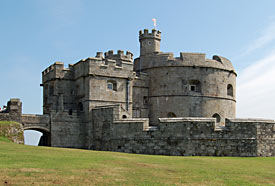
Pendennis Castle, on Pendennis Point, Falmouth, is
Britain's warmest place.
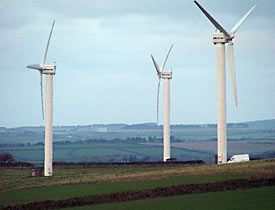
The Carland Cross wind farm just north of Truro is
Britain's second oldest, dating to 1992 and making good
use of the wind that blows through Cornwall. The ten
turbines produce up to 20 MW of power. |
Cornwall's location in the southwest
of Britain, and its shape, has a number of climate related
implications.
Having a large coastline and with much of the land
being close to the sea, and with prevailing winds coming
from the southwest, it means the sea has a major influence
on the Cornish climate.
Happily, due to the Gulf Stream offshore and its
generally more southerly location (ie further from the
North Pole and closer to the Equator) it has the mildest
and sunniest climate of the entire United Kingdom.
Also due to the Gulf Stream, Cornwall has the UK's only
area of sub-tropical climate, at the extreme south-west of
Cornwall. The sub-tropical nature has resulted in a number
of botanical gardens, such as Trebah and
the Lost Gardens of Heligan.
Pendennis Point in Falmouth is the warmest place on
mainland Great Britain, with an average temperature of
11.4 °C (52.5 °F). But at the other extreme, the
moderately high elevations of Bodmin Moor (up to 1368 ft)
see it with lower temperatures and more rain than most of
the rest of Cornwall and substantially more snow in
winter.
While the climate is officially labeled as
sub-tropical, that does not mean it is hot, and it is
unusual for temperatures to exceed 70°F (21°C), and very
rare for temperatures to exceed 80°F (27°C).
Although sunny and warm, Cornwall is also moist.
The wettest time is autumn/fall and the driest is spring.
In spring, almost one day in three has measurable
precipitation, in fall, two days in three.
Cornwall is also windy, second only to western
Scotland.
Here is some
additional climate data.
|
| More Facts and Figures
about Cornwall |
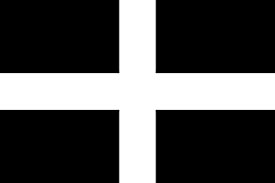
St Piran's Flag, the flag of Cornwall (Kernow),
is said to represent the white of tin contained within
the black of coal.
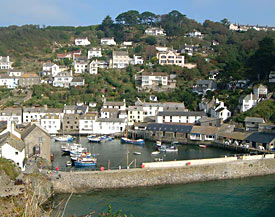
Polperro, known for its fishing and smuggling, on
Cornwall's south coast, dating to the 12th century.
Fishing used to be an important part of Cornwall's economy
but less so these days. |
Cornwall has a total population of 556,000 (per a 2016
estimate). This makes it the 40th out of England's
48 traditional counties (Greater London ranks first, while
the City of London ranks last).
On the other hand, it is one of the larger counties in
England (12th largest; North Yorkshire is the largest),
making it one of the relatively emptiest in terms of
population density (404 people per square mile,
Northumberland and Cumbria being the two least dense).
Until 1890, Cornwall included the Isles of Scilly (off
to the SW of Cornwall) but they are now independently
administered.
Until 1832, Cornwall had 44 MPs in the British
parliament, more than any other county, reflecting the
importance of Cornwall and its tin mining to the country
as a whole.
The Cornish economy lags much of the rest of Britain.
It was underpinned by tin mining until the mid-19th
century when tin mining started to decline, and these days
there are no remaining mines in production. The
county's China Clay (Kaolinite) production also declined
through the 1960s, and now only employs 2133 people.
These days the major economic activity is tourism, making
up about 25% of the economy.
|
Part
1 of a 4 part series about Cornwall. -
Please visit the other parts of this article series - click for
1. An Introduction to Cornwall
2.
Where to Stay in Cornwall
3. What to See in Cornwall
4. Touring To and Around Cornwall
Related Articles, etc
|
If so, please donate to keep the website free and fund the addition of more articles like this. Any help is most appreciated - simply click below to securely send a contribution through a credit card and Paypal.
|
Originally published
03 Jan 2018, last update
30 May 2021
You may freely reproduce or distribute this article for noncommercial purposes as long as you give credit to me as original writer.
|

